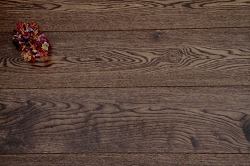
Casa Forma Welcomes You To The Ultimate Luxury Interior Design Blog
Wood is a sought-after flooring material in luxury residential and commercial interiors. When property owners search for the most suitable wood for their interior, the amount of options and industry terms are often confusing. In this blog post we aim to explain your options so when your design expert recommends one option over the other, you will be in a position to understand the thought process behind it.
Wood Flooring Types
Terms such as ‘real wood’, ‘wood effect’, ‘engineered wood’ and other terms are sometimes confusing. There are in fact two types of real wood flooring, while a distant alternative is the laminate or vinyl wood effect flooring, which should not be confused for natural wood.
Option One: Solid Wood Flooring – The solid option is made from 100% real wood. Each plank comes in random lengths and thickness of 18mm to 21mm. Solid wood flooring is suitable in most interiors, except when fitted in wet areas such as the bathroom or over under floor heating. The use of solid wood means that the floor is particularly strong making it the first choice of commercial property owners but also popular in residential properties.
Option Two: Engineered Wood Flooring – The engineered option is made from 20% or so of solid wood, whilst the rest is made from softwood, plywood and MDF to an overall thickness of 14mm to 21mm thick. It is machined made from layer upon layer of material with the solid layer always on the top and the other manmade layers below. When fitted, it looks 100% identical to the original solid type. It is suitable in all interiors, including in wet areas and on top of under floor heating. Its varied construction makes it more affordable compared to the solid wood option.
Option Three: Wood effect Flooring – The wood effect option isn’t made from natural wood and should not be considered real wood flooring. Using plastic, wood fibers or vinyl, the plank is made to resemble the natural features of wood such as sapwood, knots and of course, the golden honey colour of wood. It comes as laminate floor or vinyl wood effect floor making it substantially cheaper than real wood. Often it looks artificial or fake to a degree, as real wood is visually hard to mimic.
The Origin Of Wood
Both solid and engineered wood flooring contains natural wood which comes from forests all around the world. In recent years more and more consumers have been asking for ethically sourced wood so their decision in fitting this type of flooring does not endanger other habitats.
Most of the UK’s reputable vendors source their merchandise from managed forests in which trees are logged under strict allocation and the wood can be traced back to its source. New trees are planted to replace those who have been logged. In fact, an organisation called the FSC (FSC Forest Stewardship Council United Kingdom) credits and certifies vendors who meet this condition. These vendors will then display an FSC certificate that you can ask to read. Buying FSC wood is the responsible way to ensure ethical sourcing of wood flooring.
Wood Features Such as Sapwood, Knots and Colour Variations
Property owners are often confused as to why some examples vary in terms of colours or why some examples carry plenty of sapwood, knots, grain markings and other natural characteristic of wood, while others carry these in limited amount. This is influenced by the grade of the wood and you have a choice of four grades.
Prime and Select Grade – The two highest grades are also the dearest of the bunch. Each plank will feature minimal sapwood, knots and the planks will resemble very closely in terms of shade. These two are the ultimate in luxury grade.
Natural and Rustic Grade – The two basic grades feature plenty of sapwood, knots and colour variation should be expected. It makes the natural and rustic grade planks more affordable vs. prime and select grade.
Wood Flooring Finish
After selecting the type and grade comes the part of selecting the finish. Similarly to grade, it is a visual preference so there’s little in terms of right or wrong. There are roughly four common options that are based on variants of oil or lacquered coating.
Oil Finish – It will give the planks a matt look and is incredible hard wearing. Oil will penetrate the wood making it slower to wear. It is easy to maintain using a paintbrush and oil when required. The matt level can be heightened or lessened by applying several vs. one coat of oil.
Lacquered Finish – It will give the planks a glossy look and quicker to wear as unlike oil, lacquered is too thick to penetrate the wood. However, this makes the plank almost waterproof, which is handy if fitting engineered wood flooring in the bathroom or kitchen areas (in such case, several layers of lacquered are applied).
For information on interior design and architecture projects contact Casa Forma.
Information written by Jonathan Sapir.MD of WoodandBeyond.com a London based FSC vendor of hardwoods.
